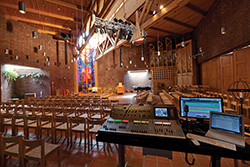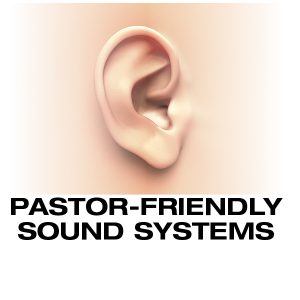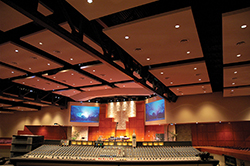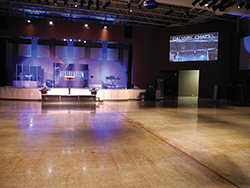
 In the ongoing quest to create better, more effective worship, the need for good sound is paramount. Whether clearly articulating a meaningful sermon or delivering a praise band’s impactful musical performance, it’s important that every person — in every seat — is treated to the best possible sonic experience.
In the ongoing quest to create better, more effective worship, the need for good sound is paramount. Whether clearly articulating a meaningful sermon or delivering a praise band’s impactful musical performance, it’s important that every person — in every seat — is treated to the best possible sonic experience.
By Rik Kirby & Daniel Keller
Assembling a good-quality sound system is rife with complexity and detail. If you’re not well-schooled in matters of audio, it’s a job best left to professionals.
Even so, it’s a good idea to have at least a basic understanding of what’s involved to ensure your worship team makes the right decisions.
 What’s in a system? Sound systems are commonly viewed as a chain of devices that capture, combine, process, route and reproduce audio. Four key components are:
What’s in a system? Sound systems are commonly viewed as a chain of devices that capture, combine, process, route and reproduce audio. Four key components are:
#1: Microphones. At the source, microphones capture the sound. While traditional services might only need one or two microphones, contemporary churches — with their larger, often amplified praise bands — can require dozens. While identifying the many microphone options is beyond the scope of this article, here are several helpful resources for those interested in delving in deeper: Microphones: Educational Content, Microphone Basics, A Basic Mic Primer: The fundamentals of microphones and how they work, Microphone Basics, Video: Microphone Basics, How do Microphones Work?
#2: Mixers. Mixers combine and control your sound sources and route the signals to processors, power amplifiers, monitor systems, and front-of-house speakers.
Mixers come in a wide range of sizes and formats. While traditional analog consoles remain popular in smaller installations, today’s digital consoles are much more affordable, powerful and flexible, and they usually offer built-in signal processing. Some also provide recording features.
Digital mixers are, therefore, fast becoming ubiquitous in even the most budget-conscious churches.

#3: Signal processors / matrix devices. Depending on the complexity of the system, you can route the signal directly from the mixer to the loudspeakers or via a signal processing / matrix device. This device typically allows zone control over multiple loudspeakers; so, for example, you can route the direct signal to the sanctuary while sending a slightly delayed or processed signal to the foyer and the cry room. In modern digital systems, the processing and matrix might also be built into the mixer.
#4: Loudspeakers. Loudspeakers are arguably the most critical part of the system, since they’re creating the sound you hear in your room. For this reason, the remainder of this article is devoted to discussing types of loudspeaker systems you might want to consider for your church.

Exploring your options
As with mixers, loudspeakers come in a wide range of shapes and styles. Many modern loudspeakers are “powered” or “active,” meaning they have onboard power amplifiers. The best choice for your church depends on your space, the type of worship service or other event, and your budget.
When selecting and configuring loudspeakers, goals should include: intelligibility for speech and music; even coverage throughout the venue; and aesthetics. To accomplish these goals, it’s crucial to direct the sound from the loudspeakers at the congregation with minimal reflection off of ceilings, floors and walls. If your sanctuary is small and acoustically well-behaved, you can do this with a familiar, point-source-type PA system employing conventional speaker cabinets, positioned on or above the stage. These systems might be arranged in a classic left-right pattern or in a central speaker cluster.

Point-source systems are relatively simple and affordable — and in some cases, portable — making them a good choice for small or mobile churches. However, they tend to distribute sound equally in all directions, so some sound reflects off ceilings, floors and walls, causing echoes and reverberation. In a larger room, this creates intelligibility problems, making it difficult (or even impossible) to clearly discern what’s being said.
Congregants in the rear hear fewer high frequencies, so the sound is increasingly dull. Since some sound energy is wasted off to the sides, more level is lost further from the loudspeakers. As a result, people in the back of the room get less sound, while those up front get blasted.

In mid-sized or odd-shaped rooms, a distributed point-source system can be created that adds satellite speakers, positioned along the side walls and in the rear of the room. A properly set up, distributed system can fill the room with sound more evenly than a single set of front speakers. However, those speakers still are generating broad beams of sound, along with plenty of reflections.
In many cases, therefore, you should consider a well-designed distributed system — or better yet, a digitally steered array. Digital beam steering uses digital signal processing (DSP) and custom software that enables the system designer to create multiple beams of sound to very precisely focus the loudspeakers’ output on the audience and away from reflective surfaces. Moreover, most of today’s digitally steered arrays are slim, low-profile speaker enclosures that blend seamlessly into the environment and are relatively easy to install.
Many larger, contemporary worship spaces consider concert-style line arrays, mimicking the systems they see on tour. Correctly designed, these line arrays provide consistent coverage and are an excellent solution for deep rooms with single-level seating.
However, traditional arrays are large and heavy, often impinging on sightlines and requiring extensive structural work to hang from ceilings and aim correctly. In spaces with one or more balconies, traditional line arrays need to be supplemented with additional speakers to ensure even coverage. With recent innovations in steerable array technology, digitally steered arrays can achieve concert-style performance while also delivering the benefits of tighter pattern control, fewer reflections, and improved intelligibility.

Get the good stuff
Loudspeakers are the only part of a sound system that generates sound; except for the mics, everything else in the system chases electrons or crunches numbers.
To get the results your congregation deserves, be sure to choose only high-quality loudspeakers that are appropriate for your space. And, have a professional install and tune the system.
Rik Kirby is Vice President, Sales & Marketing at Renkus-Heinz, Inc. Located in Southern California for over 35 years, Renkus-Heinz is a manufacturer of high-end professional loudspeaker systems.
Daniel Keller is CEO of Get It In Writing, Inc. ®


